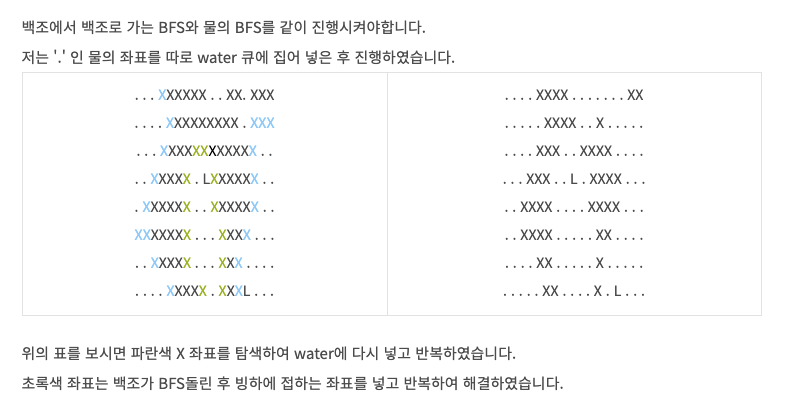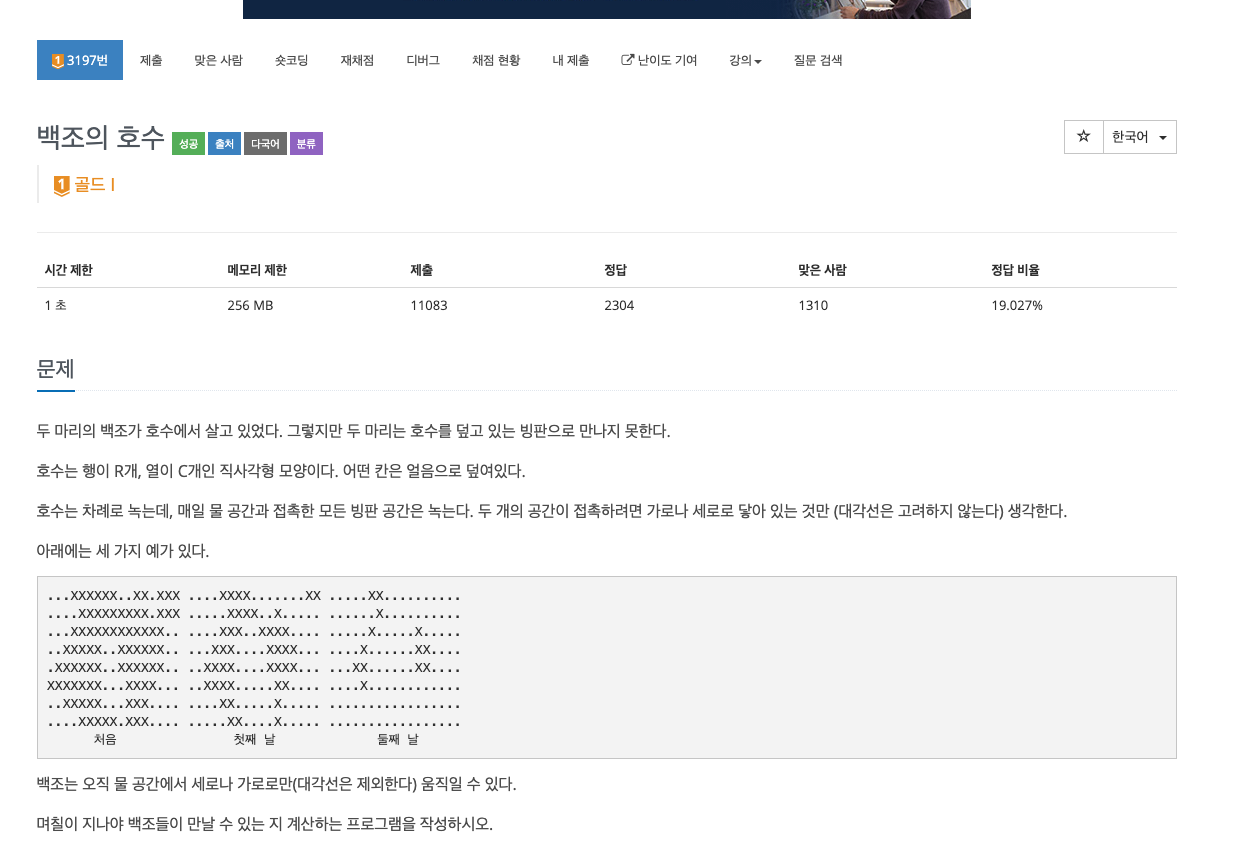[ 실패 코드(1) ] - 직관적 풀이
#include <iostream>
#include <vector>
#include <stack>
#include <queue>
#include <algorithm>
#include <cmath>
#define INF 1e9
using namespace std;
int dx[4] = {0, 1, 0, -1};
int dy[4] = {1, 0, -1, 0};
char board[1501][1501];
char board2[1501][1501];
int R, C, ans;
vector<pair<int,int>> L;
void melt()
{
for(int i=0;i<R;i++)
for(int j=0;j<C;j++)
board2[i][j] = board[i][j];
for(int i=0;i<R;i++)
{
for(int j=0;j<C;j++)
{
if(board[i][j] != 'X') continue;
bool flag = false;
for(int dir=0;dir<4;dir++)
{
int ny = i + dy[dir];
int nx = j + dx[dir];
if(nx<0 or ny<0 or nx>=C or ny>=R) continue;
if(board[ny][nx] == 'X') continue;
flag = true;
break;
}
if(flag) board2[i][j] = '.';
}
}
for(int i=0;i<R;i++)
for(int j=0;j<C;j++)
board[i][j] = board2[i][j];
}
bool check()
{
queue<pair<int,int>> q;
bool vis[R][C];
for(int i=0;i<R;i++)
fill(vis[i], vis[i]+C, false);
vis[L[0].first][L[0].second] = true;
q.push(L[0]);
while(!q.empty())
{
auto cur = q.front(); q.pop();
for(int dir=0;dir<4;dir++)
{
int ny = cur.first + dy[dir];
int nx = cur.second + dx[dir];
if(nx<0 or ny<0 or nx>=C or ny>=R) continue;
if(vis[ny][nx] or board[ny][nx] == 'X') continue;
q.push({ny, nx});
vis[ny][nx] = true;
if(board[ny][nx] == 'L') return true;
}
}
return false;
}
int main(){
ios::sync_with_stdio(0);
cin.tie(0);
cout.tie(0);
cin >> R >> C;
for(int i=0;i<R;i++)
for(int j=0;j<C;j++)
{
cin >> board[i][j];
if(board[i][j] == 'L')
L.push_back({i,j});
}
while(true)
{
if(check()) break;
melt();
ans++;
}
cout << ans;
return 0;
}
- 로직
BFS로 현재 L --> L 가능한지 검사BFS로 물에 인접한 빙하 녹이기
- 결과
: 시간초과! (해당 문제는 O(N^2)까지 허용)
- 시간 복잡도
-
check() --> O(N^2)
melt() --> O(N^2)- 최악의 경우에 가장
대각선에 백조(L)가 있고 나머지 다 빙하일 때 O(N)만큼 while문 실행
- 총 :
O(N^3)
[ 실패 코드(2) ] - 3차원 cost 계산
#include <iostream>
#include <vector>
#include <queue>
#include <cmath>
#define INF 1e9
using namespace std;
int dx[4] = {0, 1, 0, -1};
int dy[4] = {1, 0, -1, 0};
char board[1501][1501];
int cost[1501][1501][1501];
int R, C, ans=INF;
vector<pair<int,int>> L;
int main(){
ios::sync_with_stdio(0);
cin.tie(0);
cout.tie(0);
cin >> R >> C;
int B = max(R,C)+1;
for(int i=0;i<R;i++)
for(int j=0;j<C;j++)
{
cin >> board[i][j];
if(board[i][j] == 'L')
L.push_back({i,j});
}
for(int i=0;i<B;i++)
for(int j=0;j<R;j++)
for(int k=0;k<C;k++)
cost[i][j][k] = INF;
for(int i=0;i<B;i++)
cost[i][L[0].first][L[0].second] = 0;
queue<pair<pair<int,int>,int>> q;
q.push({{L[0]},0});
while(!q.empty())
{
auto cur = q.front(); q.pop();
for(int dir=0;dir<4;dir++)
{
int ny = cur.first.first + dy[dir];
int nx = cur.first.second + dx[dir];
int status = cur.second;
if(nx<0 or ny<0 or nx>=C or ny>=R) continue;
if(board[ny][nx] == 'X') status++;
if(cost[status][ny][nx] <= cost[cur.second][cur.first.first][cur.first.second] + 1) continue;
q.push({{ny, nx},status});
cost[status][ny][nx] = cost[cur.second][cur.first.first][cur.first.second] + 1;
}
}
for(int i=0;i<B;i++)
{
if(cost[i][L[1].first][L[1].second] == INF) continue;
ans = i;
break;
}
ans = ceil(ans/2.0);
cout << ans;
return 0;
}
- 느낀 점
: 3차원 cost방식(cost[status][N][M])은 입력의 수가 작고 & status가 N이 아닐 때
O(N^3) --> O(N^2)로 할 수 있음
[ 정답 풀이 ]
#include <iostream>
#include <vector>
#include <queue>
#include <cmath>
#define INF 1e9
using namespace std;
int dx[4] = {0, 1, 0, -1};
int dy[4] = {1, 0, -1, 0};
char board[1501][1501];
bool vis[1501][1501];
int R, C, day;
queue<pair<int,int>> L;
queue<pair<int,int>> W;
vector<pair<int,int>> l;
int main(){
ios::sync_with_stdio(0);
cin.tie(0);
cout.tie(0);
cin >> R >> C;
for(int i=0;i<R;i++)
for(int j=0;j<C;j++)
{
cin >> board[i][j];
if(board[i][j] == 'L') l.push_back({i,j});
if(board[i][j] == '.' or board[i][j] == 'L')
W.push({i,j});
}
L.push(l[0]);
vis[l[0].first][l[0].second] = true;
bool flag = false;
while(true)
{
queue<pair<int,int>> nextQ;
while(!L.empty())
{
auto cur = L.front(); L.pop();
for(int dir=0;dir<4;dir++)
{
int ny = cur.first + dy[dir];
int nx = cur.second + dx[dir];
if(nx<0 or ny<0 or nx>=C or ny>=R) continue;
if(vis[ny][nx]) continue;
if(board[ny][nx] == 'X')
nextQ.push({ny,nx});
else
L.push({ny, nx});
vis[ny][nx] = true;
if(ny == l[1].first and nx == l[1].second) {
flag=true;
goto stop;
}
}
}
stop:
if(flag) break;
L = nextQ;
int WSize = W.size();
while(WSize--)
{
auto cur = W.front(); W.pop();
for(int dir=0;dir<4;dir++)
{
int ny = cur.first + dy[dir];
int nx = cur.second + dx[dir];
if(nx<0 or ny<0 or nx>=C or ny>=R) continue;
if(board[ny][nx] != 'X') continue;
W.push({ny, nx});
board[ny][nx] = '.';
}
}
day++;
}
cout << day;
return 0;
}
- 로직
board[R][C] 입력 받으면서 L or .이면 빙하를 녹일 수 있으므로 W 큐에 삽입- 백조가 오늘 갈 수 있는 곳은
L 큐를 통해 계속 돌면서 백조(L)가 있는지검사
& 빙하로 막혀 다음날 갈 수 있는 곳은 nextQ 큐에 삽입
- 현재
W 큐에 있는 만큼만 돌면서 접해있는 빙하를 모두 물로 변환 (X -> .)
- 앞의 과정을 반복!
 (출처 : https://rile1036.tistory.com/115)
(출처 : https://rile1036.tistory.com/115)
- 시간 단축
- 이전 :
빙하를 녹이는 과정에 대해 2중 반복문으로 시행함 --> 무조건 O(N^2)
- 지금 :
빙하를 녹이는 과정에 대해 최초에만 모든 물에 대해 실행 & 나머지는 물이 된 빙하에 대해서만 실행
(이전 경우보다 수가 많이 줄어든다)
(추가적으로, 백조가 이동하는 과정도 다음날 갈 수 있는 좌표를 구하므로 이전날 갔던 좌표에 대한 중복 검사가 사라짐! --> 시간 단축)
- 느낀 점
꼭 필요한 부분만 탐색하기 위한 BFS를 하면 시간이 단축됨백조의 이동 / 빙하 녹음 이 2가지 행위가 필요함 --> 2개의 BFS가 필요!
2개 BFS를 따로 하는 경우를 생각해보자
(출처 : https://rile1036.tistory.com/115)

